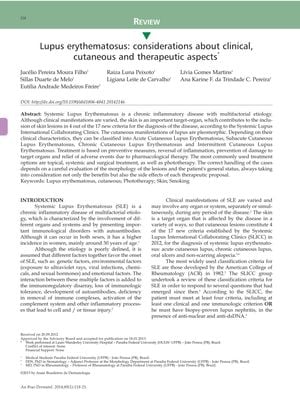Lupus Erythematosus: Considerations About Clinical, Cutaneous, and Therapeutic Aspects
January 2014
in “
Anais Brasileiros de Dermatologia
”
hydroxychloroquine sulfate methotrexate mycophenolate mofetil retinoids dapsone thalidomide clofazimine rituximab anti-cytokine therapy topical corticosteroids macrolide immunomodulators phototherapy Plaquenil Trexall CellCept Accutane Dapsone Thalomid Lamprene Rituxan topical steroids light therapy

TLDR Lupus treatment requires a combination of drugs and therapies, with research needed for new options.
The 2014 document reviews Systemic Lupus Erythematosus (SLE) and its cutaneous manifestations, emphasizing the importance of a multifaceted treatment approach. It notes that SLE is more common in women around the age of 30 and involves genetic, environmental, and emotional factors. Cutaneous Lupus Erythematosus (CLE) is treated primarily with antimalarials like hydroxychloroquine sulfate, with high response rates, and secondarily with methotrexate for refractory cases. Other treatments include mycophenolate mofetil, retinoids, dapsone, thalidomide, clofazimine, and rituximab, with the latter being used for severe cases. The document also mentions the potential of anti-cytokine therapy, the use of topical corticosteroids and macrolide immunomodulators, and phototherapy as adjuvant therapy, while surgical options are limited. It stresses the need for more research on new treatments and the consideration of histopathological changes in managing cutaneous lupus, highlighting the balance between therapeutic efficacy and adverse events.


